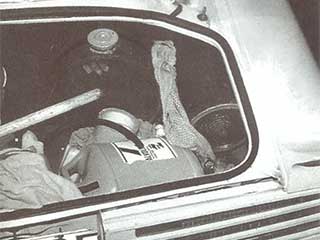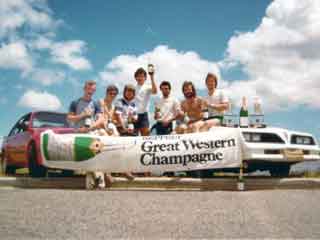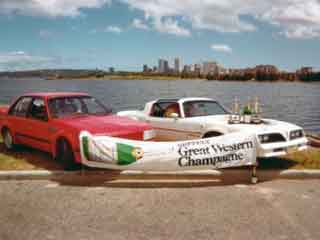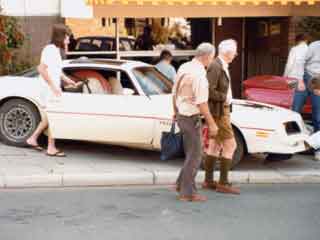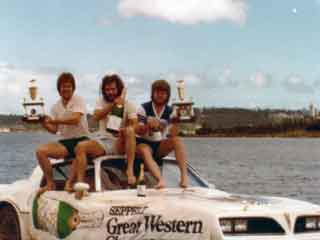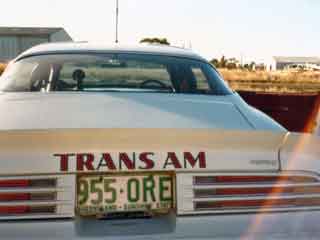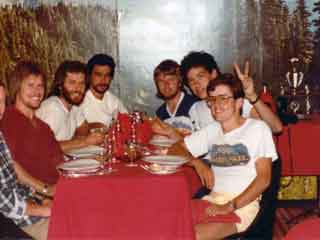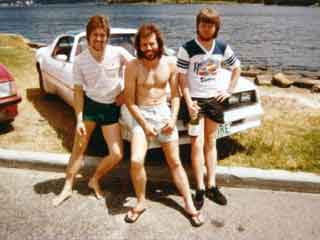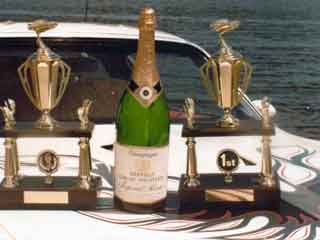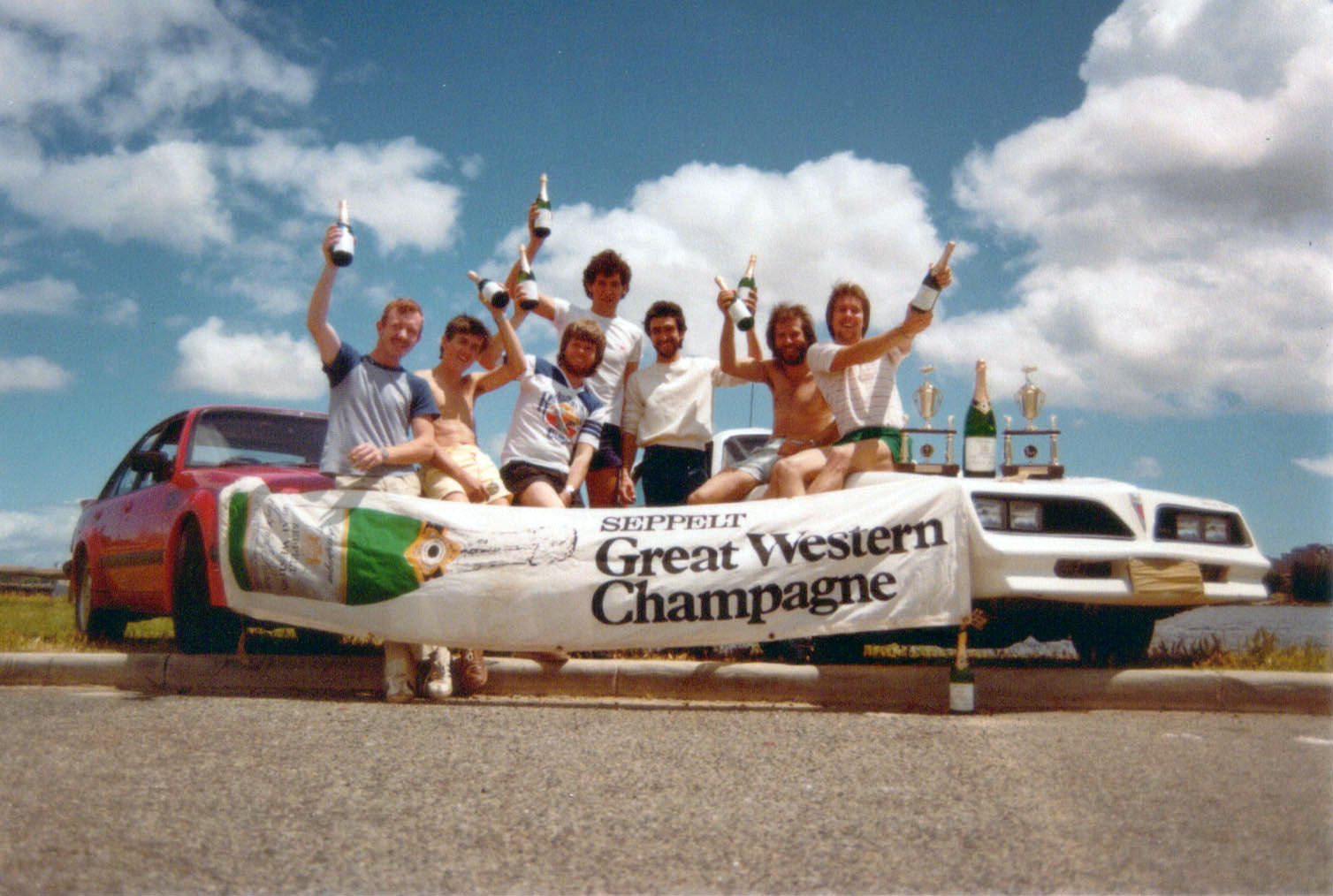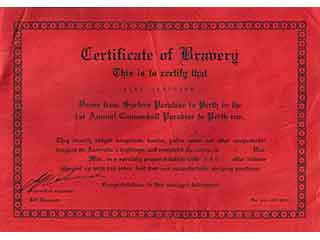1977 Pontiac Trans Am
Driven by Alex Davidson, James Davidson and Eddie Otto

The Trans Am was entered by brothers Alex and Jim Davidson, who operated a bakery in Dalby Queensland, and Eddie Otto who worked for them at the time.
Eddie had seen an advertisement for the race and mentioned it to Alex and Jim, who were keen and entered the race and asked Eddie to join them.
Alex's Trans Am was used for the race. It had the optional Oldsmobile 6.6-litre (403 ci) V8 engine and was fitted with nitrous oxide. For the race, they carried an extra fuel tank in the boot (around 60 extra litres), added a roll cage, and serviced the car including fitting new tyres.
The night before the race they met the organiser and Commodore team at the Gold Coast apartments they all stayed in and arranged to meet the following morning at 7 o'clock for the race start.
They woke at 5 o'clock and Jim says they were "nervous as hell".
The three teams gathered in the main street of Surfers Paradise and at the sound of the Commodore's horn, they all started the race. Jim drove the first leg as he had the cleanest driver's license.
Eddie says that the three cars raced through the streets out of Surfers Paradise, which were quiet at that time of the morning, and then they took a coastal route while the other two cars took an inland route.
As one of the team drove, another would navigate and make sure the driver stayed awake, and the other could rest in the back.
At fuel stops, Alex and Jim would start pumping fuel into the car's fuel tank and the extra tank in the boot. Then Jim would look after the pumps while Alex checked under the bonnet, then went to the toilet. Then Alex would take over the pumps while Jim went to the toilet. Eddie would be cleaning the windows and headlights.
They would change drivers at each fuel stop.
By their first stop within 450 km (280 miles) they had worn through the bolts that secured a plate they had fitted under the car to protect the engine through bottoming out the car on the rough roads. Before the second stop, it fell down and scraped along the road so they removed it completely and left it at the side of the road.
They didn't see any of the other teams until they stopped to refuel at Port Augusta, in South Australia. The RX-7 was just leaving, which they thought was its first fuel stop.
They followed the RX-7 for a while, which was travelling fast at 210 km/h (130 mph), and then used their nitrous oxide to overtake.
The RX-7 kept up for a while and then disappeared. They later found out it had suffered a flat tyre.
They then saw the Commodore team, which had stopped at the side of the road having run out of petrol. They were filling up from jerry cans they were carrying as the Trans Am went by.
At the next stop, they were leaving as the Commodore slid into the garage, obviously travelling very fast to try and catch them up.
But around 100 kilometres down the road the Trans Am started suffering from fuel starvation and was unable to go any faster than 175 km/h (109 mph).
The Commodore caught up and both teams pulled over to try and sort out the problem with the Trans Am.
After half an hour the RX-7 arrived and also pulled over.
They fixed an issue with the pipe from the fuel tank in the boot to the main tank which had worn through from rubbing, and they knocked a hole in the bonnet scoop to let more cold air in.
This fixed the problem and all three teams took off again, travelling across the Nullarbor Plain at 1:30 in the morning at 200 km/h (124 mph) just feet apart.
They stopped again for fuel with the Commodore. Both teams performed their fuel stops like racing car pitstops and the service station worker commented to them that they had never seen anything like it!
Early in the morning, Eddie was stopped after being detected by radar at 154 km/h (96 mph). The WA police were using in-car radar at the time and thanks to early warning from the Trans Am's radar detector, Eddie was able to slow the car down before the police were able to lock in their speed, and was booked for only 138 km/h (86 mph).
Eddie says the police asked if it was his car and were suspicious when he said it wasn't. They asked who the owner was and why he would be speeding in another person's car. Alex told him the car was his and he would have been driving much faster.
This was proved 100 kilometres (62 miles) later when Alex was stopped for speeding, at 184 km/h (114 mph)! He was brought to a stop and surrounded by three police cars and they had a plane ready in case he did not stop.
Alex was put in the back of the police car as the police were convinced they were part of a race. They were somehow able to convince the police they weren't and were able to continue on.
Jim drove the rest of the way but kept close to the speed limit as the police had said they would be watching out for them.
After 31 hours they arrived at the finish, a hotel that had been booked by the organisers in Fremantle, where they had the hotel staff record their finish time.
They had travelled the 4,400 kilometres (2,734 miles) in 31 hours – an average of 142 km/h (88 mph) including eight stops to refuel and the breakdown.
They admitted to the media achieving speeds of up to 232 km/h (144 mph).
Around 15 minutes later the solo-driven RX-7 arrived and then another half hour passed before the Commodore team finished.
After freshening up they met with the Commodore team for tea, but the RX-7 has already left headed back to Queensland.
Eddie and Alex both say the race was a great fun event.
Alex and Jim competed again in the second race in 1986.
They also competed in the same Trans Am in the 1994 Northern Territory Cannonball Run. The engine was changed to a 7.4-litre (454 ci), which is still fitted today. Unfortunately, they had a mechanical problem and weren't able to finish the event.
The Trans Am was recently sold to a relative and is undergoing restoration. Alex hopes to buy the car back in the future. He's also putting together a book about the car and its history in these races and other stories.

